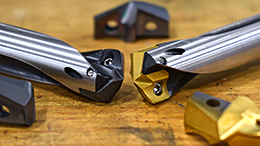HEAD-CHANGEABLE DRILLS
Modular units are often the best choice for flexibility and cost compared to solid tools
When weighing the choice of replaceable-tip mills and drills or solid-carbide tools, consider this succinct statement from one industry expert: carbide equals cost.
“Clearly, a small replaceable insert or tool head made of carbide costs less than an entire solid drill of the same diameter,” noted Andrew Pisorn, solid carbide product manager at Allied Machine & Engineering Corp., Dover, Ohio. And, by extension, using a range of replaceable-tip tools with a smaller number of steel body holders greatly improves operational and cost efficiencies by cutting down on one’s inventory of unique solid-carbide tools. “If your shop can minimize the amount of carbide in your tool cribs and drawers, you’re minimizing inventory costs.”
 Jim White, national sales manager for Carmex Precision Tools LLC, Richfield, Wis., concurred. “The reason most customers go with indexable is versatility—using one holder for multiple pitches—or cost,” he said, adding that “indexable thread mills are more cost effective in large-thread diameter applications or low-volume jobs where cycle time is not a consideration.”
Jim White, national sales manager for Carmex Precision Tools LLC, Richfield, Wis., concurred. “The reason most customers go with indexable is versatility—using one holder for multiple pitches—or cost,” he said, adding that “indexable thread mills are more cost effective in large-thread diameter applications or low-volume jobs where cycle time is not a consideration.”
Another inventory factor to consider: Shops that routinely send solid-carbide tools for regrinding must keep an adequate supply of solid tools in reserve to maintain production, said Patrick Loughney, a product manager at Sandvik Coromant, Fair Lawn, N.J.
Replaceable-tip tools can also provide users with a significant reduction in setup times, Loughney added, for instance on transfer lines for automotive manufacturing. And, with the ever-pressing shortage of experienced manufacturing labor, quick and easy tool switchouts instead of more intensive setups help ease that burden.
However, any time an operator makes changes in the machine, something can always go wrong. For instance, they must take care not to drop wrenches and screws into the machine while replacing tools.
When to Use Replaceable Tips
But what about performance? Ultimately, using replaceable-tip drilling tools generally does not mean sacrificing much penetration rate or tool life—to a point—experts assert.
“For example, if I would expect to get a thousand inches of tool life with a solid, then I would expect the same from a modular tool—but of course exceptions apply,” said Bill Pulvermacher, director of marketing for YG-1 Tool Co., Vernon Hills, Illinois. “I would expect the overall penetration rate of the solid to be just a little bit higher.” Furthermore, some users say replaceable-tip drills over 0.5“ (12.7 mm) tend to perform better in lathe applications “because they are much more tolerant of the misalignment that lathes tend to have.”
The current crop of replaceable-tip milling and drilling tools features a host of new substrates, geometries, PVD coatings and coolant solutions geared for a range of applications across numerous industries and materials. As always, the decision to use a particular tool is application specific.
When drilling difficult-to-machine materials like stainless steel or titanium, steel bodies for replaceables might torque too much, Pulvermacher cautioned. For that reason, fabricators have tended to split their use of solid and replaceable tools for those materials about 50-50, depending on the diameter. For that to change, he said, replaceable-tip tools would have to outperform solid in the 0.5-0.75“ (12.7-19.05 mm) range. Replaceable-tip drills might get the nod in larger diameters, where solid drills could cost up to $750; however, replaceables struggle under 7/16“ (11.11 mm) because they are somewhat expensive relative to solids—and the small tools, screws and inserts tend to get lost. (Jan 6,2022)


